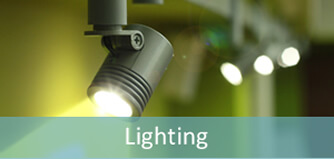


The spotlight on LED lighting
Back to Articles
From car headlights to lighting our homes, LED lighting is taking over as the default option for new lighting applications.
Why LEDs
LEDs have come a long way to being an efficient and reliable replacement in almost every imaginable application. From floodlighting, domestic and workplace environments, and available in all the major wattages and fittings, LEDs are everywhere.
They are commonly used in various applications like monitors and flat screen televisions, smartphones, tablets, car headlights and indicators, traffic lights, Christmas tree lights, signage, and entertainment applications. As this energy-efficient technology develops, so do the many uses for LEDs.
Did you know - LEDs
Unlike traditional light bulbs that produce light from heat, also known as incandescence, LEDs’ shine is the result electrical voltage, known as electroluminescence.
LEDs emit extremely low levels of UV, which makes them far less attractive to insects than traditional incandescent lights.
Good quality LEDs, like those you can purchase from reliable companies like Bradcher, can easily exceed 50 000 hours of lighting in their lifetime.
Blue LEDs can help keep food fresher as they have a strong antibacterial effect on foodborne pathogens. As a result, they’re increasingly being used in fridges.
LEDs and agriculture
LEDs can stimulate plant growth significantly while drastically reducing energy consumption by providing more targeted lighting. With the emerging trend of urban farming this will offer substantial benefits.
LEDs light the street, smartly
LED streetlights offer increased visibility with the benefit reduced energy consumption, which is why more municipalities are switching to this unique light source.
Different LED types
Coloured LEDs
Wavelength is what differentiates coloured, infrared, and ultra-violet LEDs. LED wavelength is achieved by the semiconductor material used within and the wavelength value will give you an idea of the colour the LED will emit. However, if you’re not sure, chat to the team at Bradcher for advice.
White LEDs
There is a vast range of white hues and tones to choose from because white LEDs are not actually white – it is an effect created by mixing red, green, and blue LEDs. White LEDs can also be created through coating a blue LED with yellow phosphor to emit a light that appears white.
- Warm whites have a yellow-red tone and are cosy and calming. They are often used in homes, hotels, and restaurants for a subtle a candlelight tone.
- Cool whites have an icy blue tone that is harsher and usually found in industrial environments and street lighting.
- Neutral whites are somewhere between warm and cool whites and are the preferred choice for classrooms, retail, and office settings.
- The colour temperature of white light is measured in Kelvin (K) and the lower the value, the warmer the white. The team at Bradcher can help you find the right colour for your needs.
Infrared (IR) and ultra-violet (UV) LEDs
Infrared (IR) LEDs are commonly found in remote controls, touchscreens, motion sensors, and smart watches. Infrared LEDs are usually positioned around the outside of the camera or goggle lens of security cameras to capture IR images in zero-light conditions, and even through smoke or fog.
Ultra-violet (UV) LEDs are commonly used in tanning salons, aquarium lights and medical treatments. UV curing of adhesives, inks and coatings are moving to UV LEDs, which safer, with lower levels of UV radiation emitted, and of course, more energy efficient.
UV LEDs are also used in water purification and disinfection applications.
Contact Bradcher – LED experts
If you have any questions about the right LEDs for your needs, contact the team at Bradcher for advice.
CONTACT US
| Wayne Simpson | |
| Cell Number: | (083) 628 6719 |
| Telephone Number: | (011) 425 4447 |
| Fax Number: | (086) 245 6091 |
| Email Address: | wayne@bradcher.co.za |
Tel: (011) 425 4447 | Email: wayne@bradcher.co.za | Articles | Privacy Policy | © 2014 Bradcher | Designed by Right Click Media




